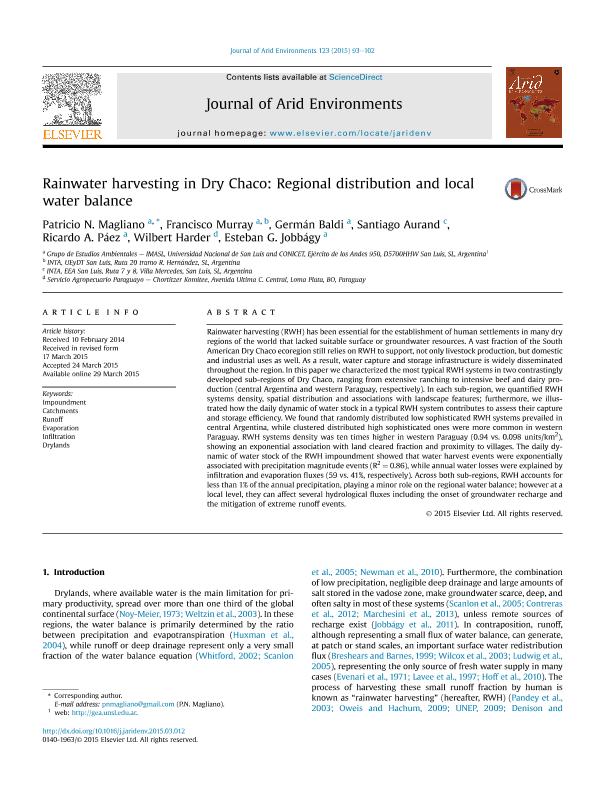Mostrar el registro sencillo del ítem
dc.contributor.author
Magliano, Patricio Nicolás

dc.contributor.author
Murray, Francisco
dc.contributor.author
Baldi, Germán

dc.contributor.author
Aurand, Santiago
dc.contributor.author
Paez, Ricardo Andrés

dc.contributor.author
Harder, Wilbert
dc.contributor.author
Jobbagy Gampel, Esteban Gabriel

dc.date.available
2017-04-04T20:33:33Z
dc.date.issued
2015-12
dc.identifier.citation
Magliano, Patricio Nicolás; Murray, Francisco; Baldi, Germán; Aurand, Santiago; Paez, Ricardo Andrés; et al.; Rainwater harvesting in the Dry Chaco: Regional distribution and local water balance; Elsevier; Journal Of Arid Environments; 123; 12-2015; 93-102
dc.identifier.issn
0140-1963
dc.identifier.uri
http://hdl.handle.net/11336/14807
dc.description.abstract
Rainwater harvesting (RWH) has been essential for the establishment of human settlements in many dry regions of the world that lacked suitable surface or groundwater resources. A vast fraction of the South American Dry Chaco ecoregion still relies on RWH to support, not only livestock production, but domestic and industrial uses as well. As a result, water capture and storage infrastructure is widely disseminated throughout the region. In this paper we characterized the most typical RWH systems in two contrastingly developed sub-regions of Dry Chaco, ranging from extensive ranching to intensive beef and dairy production (central Argentina and western Paraguay, respectively). In each sub-region, we quantified RWH systems density, spatial distribution and associations with landscape features; furthermore, we illustrated how the daily dynamic of water stock in a typical RWH system contributes to assess their capture and storage efficiency. We found that randomly distributed low sophisticated RWH systems prevailed in central Argentina, while clustered distributed high sophisticated ones were more common in western Paraguay. RWH systems density was ten times higher in western Paraguay (0.94 vs. 0.098 units/km2), showing an exponential association with land cleared fraction and proximity to villages. The daily dynamic of water stock of the RWH impoundment showed that water harvest events were exponentially associated with precipitation magnitude events (R2 = 0.86), while annual water losses were explained by infiltration and evaporation fluxes (59 vs. 41%, respectively). Across both sub-regions, RWH accounts for less than 1% of the annual precipitation, playing a minor role on the regional water balance; however at a local level, they can affect several hydrological fluxes including the onset of groundwater recharge and the mitigation of extreme runoff events.
dc.format
application/pdf
dc.language.iso
eng
dc.publisher
Elsevier

dc.rights
info:eu-repo/semantics/openAccess
dc.rights.uri
https://creativecommons.org/licenses/by-nc-nd/2.5/ar/
dc.subject
Impoundment
dc.subject
Catchments
dc.subject
Runoff
dc.subject
Evaporation
dc.subject
Infiltration
dc.subject
Drylands
dc.subject.classification
Oceanografía, Hidrología, Recursos Hídricos

dc.subject.classification
Ciencias de la Tierra y relacionadas con el Medio Ambiente

dc.subject.classification
CIENCIAS NATURALES Y EXACTAS

dc.title
Rainwater harvesting in the Dry Chaco: Regional distribution and local water balance
dc.type
info:eu-repo/semantics/article
dc.type
info:ar-repo/semantics/artículo
dc.type
info:eu-repo/semantics/publishedVersion
dc.date.updated
2017-03-31T18:13:52Z
dc.journal.volume
123
dc.journal.pagination
93-102
dc.journal.pais
Países Bajos

dc.journal.ciudad
Amsterdam
dc.description.fil
Fil: Magliano, Patricio Nicolás. Consejo Nacional de Investigaciones Científicas y Técnicas. Centro Científico Tecnológico San Luis. Instituto de Matemática Aplicada de San Luis; Argentina
dc.description.fil
Fil: Murray, Francisco. Consejo Nacional de Investigaciones Científicas y Técnicas. Centro Científico Tecnológico San Luis. Instituto de Matemática Aplicada de San Luis; Argentina. Instituto Nacional de Tecnología Agropecuaria; Argentina
dc.description.fil
Fil: Baldi, Germán. Consejo Nacional de Investigaciones Científicas y Técnicas. Centro Científico Tecnológico San Luis. Instituto de Matemática Aplicada de San Luis; Argentina
dc.description.fil
Fil: Aurand, Santiago. Instituto Nacional de Tecnología Agropecuaria; Argentina
dc.description.fil
Fil: Paez, Ricardo Andrés. Consejo Nacional de Investigaciones Científicas y Técnicas. Centro Científico Tecnológico San Luis. Instituto de Matemática Aplicada de San Luis; Argentina
dc.description.fil
Fil: Harder, Wilbert. Servicio Agropecuario Paraguayo; Paraguay
dc.description.fil
Fil: Jobbagy Gampel, Esteban Gabriel. Consejo Nacional de Investigaciones Científicas y Técnicas. Centro Científico Tecnológico San Luis. Instituto de Matemática Aplicada de San Luis; Argentina
dc.journal.title
Journal Of Arid Environments

dc.relation.alternativeid
info:eu-repo/semantics/altIdentifier/url/http://www.sciencedirect.com/science/article/pii/S0140196315000865
dc.relation.alternativeid
info:eu-repo/semantics/altIdentifier/url/http://dx.doi.org/10.1016/j.jaridenv.2015.03.012
Archivos asociados
